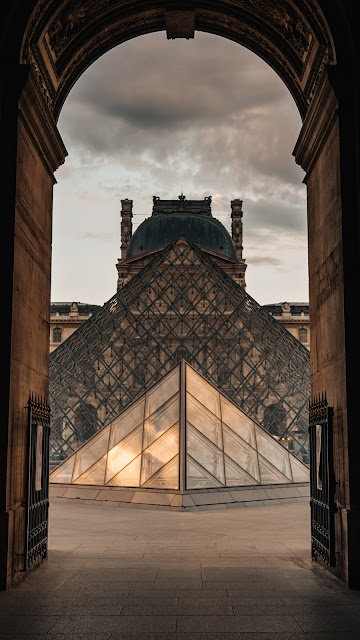 The Louvre was originally built as a fortress in 1190, but was reconstructed in the 16th century to serve as a royal palace. "Like many buildings, it was built and rebuilt over the years," said Tea Gudek Snajdar, an Amsterdam-based art historian, museum docent and a blogger at Culture Tourist.
The Louvre was originally built as a fortress in 1190, but was reconstructed in the 16th century to serve as a royal palace. "Like many buildings, it was built and rebuilt over the years," said Tea Gudek Snajdar, an Amsterdam-based art historian, museum docent and a blogger at Culture Tourist.
6 SECRETS OF THE LOUVRE
1. Once upon a time, it was originally a palace
In the mid-16th century, Francios I commissioned the Louvre Palace to be built over the site of a former Medieval 12th-century fortress. All subsequent kings occupied the palace until Louis XIV built the Palace of Versailles. This became the main residence of the French monarch, leaving the unoccupied Louvre to become a stomping ground for squatters. It opened partially as a museum in 1793, during the revolution, and the whole building officially opened as a museum in 1993.
2. It’s home to a school
The École du Louvre, located in the museum itself, is a higher educational institution that lets art enthusiasts study archaeology, art history, anthropology, and epigraphy among one of the esteemed and dreamiest backdrops. Needless to say, it’s quite competitive and while many begin their studies immediately after high school, university students who have at least two or three years of education under their belt in certain subjects may apply and transfer.
3. Napoleonic booty
It’s no secret that Napoleon was a conquerer and during his conquests, he plundered lots of art and many of these works are displayed at the museum today. He went to town when he invaded Italy and took many of the country’s masterpieces for himself. Paolo Veronese’s Wedding Feast at Cana (1553) is the museum’s largest painting and hangs just opposite the Mona Lisa . You can gaze at it for a hours and still feel like you haven’t fully taken it in. He pilfered this from the refectory of San Giorgio Maggiore in Venice and it was so large, that he actually had it cut in half so he could bring it back to Paris.
4. Pyramid controversy
Nowadays, I.M. Pei’s glass pyramid outside the Louvre is just as emblematic of Paris as the Eiffel Tower. But it wasn’t so beloved following the 1989 reveal. Many considered the pyramid, along with its two diminutive counterparts, a sacrilegious eyesore. The critics claimed the juxtaposition of the contemporary structure against the older architecture robbed the latter of its integrity. However, life went on and the pyramid has prevailed.
5. It has a sister in the Middle East
The Louvre in Paris isn’t the only Louvre in the world: the Jean Nouvel-designed Louvre Abu Dhabi opened in 2017 as part of a joint venture between the governments of the United Arab Emirates and France that permits the UAE to use the Louvre name for 30 years, an arrangement that was ten years in the making. The museum displays more than 600 artworks, with 300 rotating works that are part of the four annual temporary exhibits organized by 13 French museum partners. It also boasts an interesting design component: a dome that’s 180 meters in diameter and comprised of 8,000 geometric, through which sunlight in the shape of stars shines on the museum patrons.
6. A wartime evacuation
During World War II, Jacques Jaujard, the museum’s director, had the foresight to thwart the imminent Nazi occupation. Hitler loved art and the Nazis notoriously pillaged on his behalf, so Jaujard organized the relocation of 4,000 of the most valuable artworks. They were taken to the Loire Valley and hidden in the Chateau de Chambord during the war. To keep the treasured Mona Lisa extra safe, he marked it with a secret code and made sure not to indicate the crate carrying it. When he later transferred the work to the Château de Louvigny, the second of several wartime hiding places, it was concealed on an ambulance stretcher.
A historic building
The architecture of the Louvre
The Salle Saint-Louis: the oldest room in the palace
.jpg) |
| Louvre médiéval, salle Saint-Louis |
The organisation of the collections
A living museum
The Mona Lisa

At the climax of the 2006 film adaptation, the camera elaborately moves through the entire glass pyramid from above and then descends beneath the floor below to reveal the supposed hidden chamber under the tiny stone pyramid, containing the sarcophagus with the remains of Mary Magdalene.
Polished up for a supporting role in the film version of The Da Vinci Code, they played the fictional Rose Line. After that, Dan Brown's fans sought them out. They even looked for them at the Church of St. Sulpice, which figures in The Da Vinci Code but is not on the Paris Meridian.

After sunset on May 31, 1983, and before dawn the next morning, a showcase at the Louvre was broken into and two pieces of 16th-century Italian armor were stolen in one of the most mysterious heists in the museum's history.
This is one of the Louvre Museum's treasures. Acquired in 1902, it came from the church of Saint Mary Magdalene in the Dominican convent of Augsburg. She was originally accompanied by sculpted angels. It is said that Mary Magdalene was clothed only by her own hair.

.jpg)
.jpg)
.jpg)


















.jpg)





0 Comments
If you have any doubts or questions, let me know.